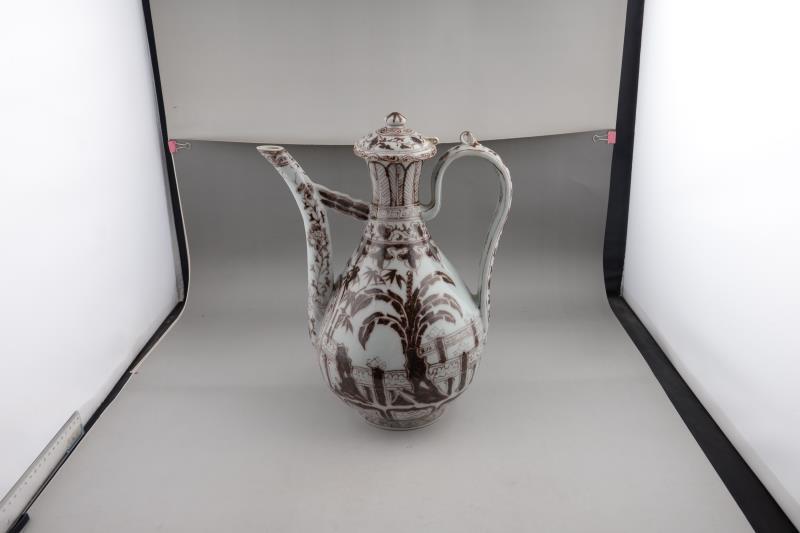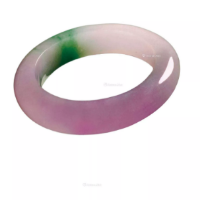釉里红瓷创烧于元代,但数量极少,可谓凤毛麟角。原因是铜离子对温度极为敏感,在窑炉中火候不到,呈现黑红色或灰红色;火候销过铜离子便挥发,从釉层中逸出,呈现特有的飞红现象或干脆退色,纹饰不连贯。然而到了明洪武朝,釉里红瓷却得到了极大的发展。 Red enamel was first fired in the Yuan Dynasty, but its quantity is very small, so it is rare. The reason is that copper ions are extremely sensitive to temperature, and they are black red or grey red when they are not fired in the kiln; copper ions volatilize when they are fired and escape from the glaze layer, showing a unique phenomenon of flying red or simply fading, and the decoration is incoherent. However, in the Ming and Hongwu Dynasties, the glazed red porcelain has been greatly developed.

此壶唇口,带盖,细颈,斜肩,硕腹,圈足。壶身作玉壶春瓶式,壶体一侧置弯曲细长的壶流,并以一云板形饰件与壶身相连,另一侧置曲柄,连接于颈腹之间,柄上端置一小系。壶通体绘釉里红纹饰,唇口绘回纹一周,颈部分层绘焦叶纹、回纹、缠枝灵芝纹各一周,双腹绘竹叶蕉叶纹,壶柄绘有缠枝栀子花等纹饰,近足处为一周变形莲瓣纹,足内满施白釉,无款。 The lip of the pot is covered, with a thin neck, oblique shoulders, large belly and circled feet. The pot body is a spring bottle of jade pot. One side of the pot body is provided with a curved and slender pot flow, which is connected with the pot body by a cloud plate decoration, and the other side is provided with a crank, which is connected between the neck and abdomen, with a small series at the upper end of the handle. Hutong body is painted with red pattern in glaze, one week with lip, one week with coke leaf pattern, palindrome pattern and twisted Ganoderma lucidum pattern on neck, one week with bamboo leaf and banana leaf pattern on both abdomen, and one week with twisted Gardenia Flower on handle. Near foot is a deformed lotus petal pattern with white glaze on foot.
此壶造型优美,纹饰线条流畅,一气呵成。在装饰风格延续了元代纹饰繁密的特点,布局渐趋疏朗,采用分层装饰的手法,绘画粗犷而不失工整,具有鲜明的时代特征。明洪武时期的釉里红瓷器多为大盘、大碗、大罐、玉壶春瓶、梅瓶、执壶等大件器物,纹饰以各种缠枝、折枝和串枝花卉为主,此外还有松竹梅、庭院芭蕉及龙凤等纹饰。此时期的釉里红发色不甚鲜艳,多为红中偏灰黑为深褐色的色调,此执壶具有典型的元末明处时期的工艺特征,画工精美,胎骨老道,釉色显温润,器型完整雅观而大气,是收藏爱好者难得一见的珍品,存世绝少,流入民间更是凤毛麟角,是不可多得的藏界之重器,具有极高的历史纪念价值。
This pot is beautiful in shape, smooth in decoration lines, and it is finished in one go. The decorative style continued the dense features of Yuan Dynasty decoration, the layout became more and more sparse, and the layered decoration method was adopted. The painting was rough and neat, with distinct characteristics of the times. During the Hongwu period of the Ming Dynasty, most of the glazed red porcelains were large plates, large bowls, large pots, jade pots, spring bottles, plum bottles, holding pots and other large objects. The decorations were mainly twisted branches, broken branches and twisted flowers. In addition, there were pines, bamboo plums, garden bananas and dragons and phoenixes. At this time, the glaze red hair color is not very bright, mostly dark brown in red, gray and black. This pot has typical characteristics of the late Yuan Dynasty and Ming Dynasty. It is a rare treasure for collectors because of its exquisite workmanship, mature fetal bones, warm glaze color, complete and elegant shape. It is rare for collectors to survive in the world. It is also a rare treasure in the Tibetan world. It has very high historical commemorative value.
洪武早期的制品多呈黑红,不够鲜艳,甚至有些烧成了"釉里黑"也未被打碎埋掉。即便如此,此类品种贯穿洪武朝始终,坚持不懈。中、晚期多呈较纯正红色。风格古朴、厚重,器型硕大,纹饰丰满,气势夺人。充分展示了明朝开国之君的胸怀与气度。Hongwu's early products were mostly black and red, not bright enough, and even some of them were burned into "glaze black" and were not broken and buried. Even so, this kind of variety runs through the Hongwu Dynasty and perseveres. In the middle and late stages, most of them were pure red. Style simple, thick, large, full decoration, momentum. It fully demonstrates the mind and demeanor of the founder of the Ming Dynasty.



